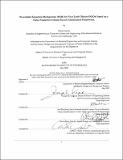| dc.contributor.advisor | Joseph M. Sussman and Anil Bhardwaj. | en_US |
| dc.contributor.author | Sahani, Rohan | en_US |
| dc.contributor.other | System Design and Management Program. | en_US |
| dc.date.accessioned | 2008-02-27T20:38:59Z | |
| dc.date.available | 2008-02-27T20:38:59Z | |
| dc.date.copyright | 2007 | en_US |
| dc.date.issued | 2007 | en_US |
| dc.identifier.uri | http://hdl.handle.net/1721.1/40328 | |
| dc.description | Thesis (S.M.)--Massachusetts Institute of Technology, Dept. of Electrical Engineering and Computer Science; and, (S.M.)--Massachusetts Institute of Technology, System Design and Management Program, 2007. | en_US |
| dc.description | This electronic version was submitted by the student author. The certified thesis is available in the Institute Archives and Special Collections. | en_US |
| dc.description | Includes bibliographical references (p. 193-198). | en_US |
| dc.description.abstract | There is a significant amount of space debris from previous space endeavors left over by the Russians and the US, leave alone the possibility of collisions with Near Earth Objects (NEOs) like asteroids and comets. Currently, there is no early detection and emergency response system in place. This study will apply the CLIOS (Complex Large Interconnected Open Socio-technical) Process to design and construct novel and unique strategic alternatives for possible detection, defense and tracking systems which are not currently in use. A software application will demonstrate the dynamics of this new classification scheme for Near Earth Objects (NEOs) that would correspond to a set of Prevention Sequence Mechanisms (PSM) which represent a specific sequence of deterrence mechanisms. Potentially dangerous NEOs were classified into various groups that were derived from three different classes based on NEO size, Time-to-Impact (TTI) and chemical composition. For each NEO group, corresponding PSMs were designed. Each PSM illustrates the best possible sequence in which a set of prevention mechanisms (applicable to a specific NEO group of our classification scheme) are to be implemented. A software-package called PDTS 1.0 was designed for tracking and cataloging potentially hazardous NEOs based on the PSM framework and the three-parameter based classification scheme. Through mutual collaboration and segmentation of PSM modules the mitigation effort was optimized. Therefore, in future, if an NEO on collision course with the Earth is detected then the group name of that NEO is found from our classification scheme and the corresponding PSM for that group is implemented to deflect or destroy the NEO. | en_US |
| dc.description.statementofresponsibility | by Rohan Sahani. | en_US |
| dc.format.extent | 198 p. | en_US |
| dc.language.iso | eng | en_US |
| dc.publisher | Massachusetts Institute of Technology | en_US |
| dc.rights | M.I.T. theses are protected by copyright. They may be viewed from this source for any purpose, but reproduction or distribution in any format is prohibited without written permission. See provided URL for inquiries about permission. | en_US |
| dc.rights.uri | http://dspace.mit.edu/handle/1721.1/7582 | |
| dc.subject | Electrical Engineering and Computer Science. | en_US |
| dc.subject | System Design and Management Program. | en_US |
| dc.title | Prevention sequence mechanisms (PSM) for Near Earth Objects (NEOs) based on a three parameter scheme based classification framework | en_US |
| dc.title.alternative | PSM for NEOs based on a three parameter scheme based classification framework | en_US |
| dc.title.alternative | Prevention sequence mechanisms for Near Earth Objects (NEOs) based on a three parameter scheme based classification framework | en_US |
| dc.title.alternative | PSM for Near Earth Objects (NEOs) based on a three parameter scheme based classification framework | en_US |
| dc.type | Thesis | en_US |
| dc.description.degree | S.M. | en_US |
| dc.contributor.department | System Design and Management Program. | en_US |
| dc.contributor.department | Massachusetts Institute of Technology. Department of Electrical Engineering and Computer Science | |
| dc.identifier.oclc | 191960807 | en_US |
